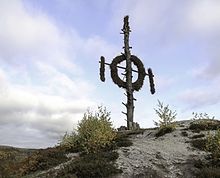Sun cross


A sun cross, solar cross, or wheel cross is a solar symbol consisting of an equilateral cross inside a circle.
The design is frequently found in the symbolism of prehistoric cultures, particularly during the Neolithic to Bronze Age periods of European prehistory. The symbol's ubiquity and apparent importance in prehistoric religion have given rise to its interpretation as a solar symbol, whence the modern English term "sun cross" (a calque of Template:Lang-de).
The same symbol is in use as a modern astronomical symbol representing the Earth rather than the Sun.
The symbol can be depicted using Unicode as U+1F728 🜨 ALCHEMICAL SYMBOL FOR VERDIGRIS. The characters U+2295 ⊕ CIRCLED PLUS and U+2A01 ⨁ N-ARY CIRCLED PLUS OPERATOR are similar in appearance but represent mathematical operators.
Interpretation as solar symbol

The interpretation of the simple equilateral cross as a solar symbol in Bronze Age religion was widespread in 19th-century scholarship. The cross-in-a-circle was interpreted as a solar symbol derived from the interpretation of the disc of the Sun as the wheel of the chariot of the Sun god.[1] Wieseler (1881) postulated an (unattested) Gothic rune hvel ("wheel") representing the solar deity by the "wheel" symbol of a cross-in-a-circle, reflected by the Gothic letter hwair (𐍈).[2]
The English term "Sun-Cross", on the other hand, is comparatively recent, apparently loaned from German Sonnenkreuz and used in the 1955 translation of Rudolf Koch's Book of Signs ("The Sun-Cross or Cross of Wotan", p. 94).
The German term Sonnenkreuz was used in 19th-century scholarly literature of any cross symbol interpreted as a solar symbol, an equilateral cross either with or without a circle, or an oblique cross (Saint Andrew's cross). Sonnenkreuz was used of the flag design of the Paneuropean Union in the 1920s.[3] In the 1930s, a version of the symbol with broken arms (resembling a swastika) was popular as a link between Christianity and Germanic paganism in the völkisch German Faith Movement.[4]
Popular legend in Ireland says that the Celtic Christian cross was introduced by Saint Patrick or possibly Saint Declan, though there are no examples from this early period. It has often been claimed that Patrick combined the symbol of Christianity with the sun cross to give pagan followers an idea of the importance of the cross. By linking it with the idea of the life-giving properties of the sun, these two ideas were linked to appeal to pagans. Other interpretations claim that placing the cross on top of the circle represents Christ's supremacy over the pagan sun.
The vertical bar represents North and South while the horizontal bar is East and West. There is a 31 degree saltire that is also associated with this symbol. When laid over the cross it represents the solstices and equinoxes with precision. This configuration is an ideogram reflected through many cultures and extends far back into antiquity. Henges are a testament that there was an ancient understanding of the Sun's behavior in the sky and that it was measurable, predictable and center to their continued existence on Earth.
The original Coptic cross often includes a circle that is derived from the ankh, as the circles represent the sun god, Ra. Early Gnostic sects also used a circle cross.
Archaeological record
Bronze Age


In the prehistoric religion of Bronze Age Europe, crosses in circles appear frequently on artifacts identified as cult items, for example the "miniature standard" with an amber inlay that shows a cross shape when held against the light, dating to the Nordic Bronze Age, held at the National Museum of Denmark, Copenhagen.[5] The Bronze Age symbol has also been connected with the spoked chariot wheel, which at the time was four-spoked (compare the Linear B ideogram 243 "wheel" 𐃏). In the context of a culture that celebrated the sun chariot, it may thus have had a "solar" connotation (compare the Trundholm sun chariot).
Modern culture
Astronomy
The same symbol represents the Earth in astronomical symbols, while the Sun is represented by a circle with a center point.
Ethnography
The Native Americans and other indigenous peoples continue using the solar cross on their symbolic and as decoration practices.
Music
In modern music tablature, the solar cross denotes a change of an acoustic guitar tone distortion.
Politics
The Sassanian Empire in Persia used a similar solar cross on their banner, called the Derafsh Kaviani symbol.
The Norwegian fascist party Nasjonal Samling used a golden sun cross on a red background as an official symbol from 1933 to 1945. The cross with the circle was attached to Olaf II of Norway, patron saint of Norway, and the colors were the coat of arms of Norway.
The Paneuropean Union similarly uses this symbol as central element of its flag.
Religion and Neopaganism
In Wicca, the solar cross represents not only the Sun but also the four quadrants of the Wheel of the Year, the cycle of the four seasons.
Among other symbols, neo-paganism used the sun cross for the reconstruction of faith and pagan culture, particularly the Celtic neopaganism, the heathenism, especially the Ásatrú, and other beliefs such as Norse paganism.
Examples
-
Earth astronomical symbol
-
Broken sun cross swastika
-
Caddo sun cross
-
Ashur sun cross
-
Bayer logo
-
FC Steaua București logo since 2015
See also
{{Columns-list|
- Astrological symbols
- Black Sun (occult symbol)
- Celtic cross
- Coptic cross
- Cross
- Direct sum
- Earth symbol
- Exclusive or
- Ringed cross
- Solar symbol
- Swastika
- Tursaansydän
- Western use of the swastika in the early 20th century
References
- ^ Martin Persson Nilsson (1950). The Minoan–Mycenaean Religion and its Survival in Greek Religion. Biblo & Tannen Publishers. p. 421.
there is a wide-spread opinion that the equal-limbed cross is another symbol of the sun. It was, for example, a favorite theory of the late Professor Montelius, and has been embraced by many other archaeologists; its wide acceptance being due to an interest in finding a pre-Christian origin of the symbol of Christianity. The disc of the sun was regarded as a wheel; hence the myth that the sun-god drives in a chariot across the heavens.
- ^ Karl Georg Wieseler (1813–83), Untersuchungen Zur Geschichte Und Religion Der Alten Germanen in Asien und Europa, 1881, p. 157. The suggestion of a specifically Gothic variant of the runic alphabet partially preserved in the Gothic alphabet is due to Jacob Grimm's Deutsche Mythologie (1835).
- ^ Richard Nicolaus Graf von Coudenhove-Kalergi, Kampf um Paneuropa aus dem 1. Jahrgang von Paneuropa, Paneuropa Verlag, 1925, p. 36.
- ^ For example:
- Karl Hans Strobl, Die Runen und das Marterholz, Zwinger-Verlag, 1936, p. 138
- Waldemar Müller-Eberhart, Kopf und herz des Weltkrieges: General Ludendorffs Wertung als Deutscher, Georg Kummer, 1935, p. 244.
- ^ entry at the Nebra sky disk exhibition site (landesmuseum-fuer-vorgeschichte-halle.de)







